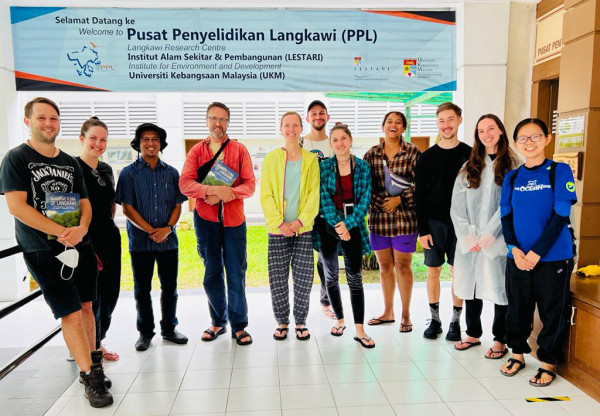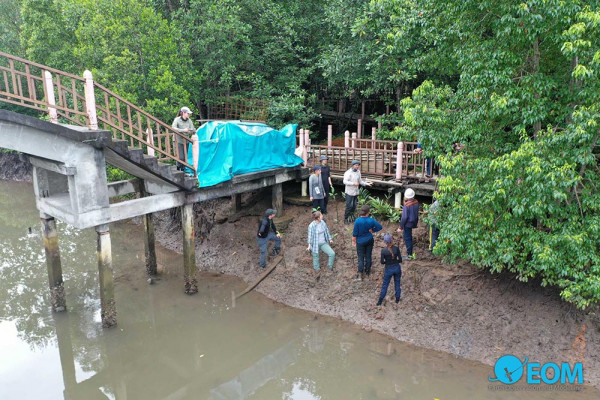At the end of September a team of ten German researchers started their journey to the other side of the world – to be more precise, to the Malaysian Peninsula in the context of the project sea4soCiety. Our young and diverse team was made up of scientists from four different research institutions in Germany.
Theresa Fett, Mondane Fouqueray, Moritz Nusser, Martin Zimmer, and Mirco Wölfelschneider (myself) from ZMT, were joined by Jana Geuer from the Max Planck Institute fpr Marine Microbiology (MPI), Lea Fricke from the University of Kiel, as well as Clarisse Gösele, Lia Ruhrus, and Robin Aßmann, from the University of Hamburg. Our team was completed by Aldrie Amir from UKM in Kuala Lumpur, Jen Nie Lee, Chai Kee Ong, and Wei Yien Lua from UMT in Kuala Terengganu.
At the research station Pusat Penyelidikan Langkawi (from left to right): Mirco Wölfelschneider (ZMT), Lea Fricke (University of Kiel), Aldrie Amir (UKM), Martin Zimmer (ZMT), Theresa Fett (ZMT), Robin Aßmann (University of Hamburg), Lia Ruhrus (University of Hamburg), Clarisse Gösele (University of Hamburg), Moritz Nusser (ZMT), Mondane Fouqueray (ZMT), Chai Kee Ong (UMT), and unfortunately in bed to recover Jana Geuer (MPI).
In a nutshell: Within sea4soCiety, we want to quantify and evaluate the carbon storage capacities of the coastal vegetated ecosystems in Germany (saltmarshes, seagrass meadows, and kelp forests). In the tropics this set of four is rounded off with mangrove forests, whereas the kelp forests are being replaced with floating Sargassum patches. By putting all the acquired data together, we plan to develop a roadmap on how coastal vegetated ecosystems can help reduce carbon dioxide levels in our atmosphere and stabilize our climate. If you want to know more details, please take a look at our webpage https://sea4society.cdrmare.de/ or contact us.
In order to achieve our grand scheme, we collected gas, porewater, sediment, and leaf samples, as well as biometric and abiotic measurements from mangrove forests, seagrass beds, salt marshes, and vegetation-free areas as references at three different locations in Malaysia. Additionally, hours of qualitative interviews with local stakeholders were recorded in and around Setiu Wetlands. Our three sampling locations were the island of Langkawi, located off the north-western shore of the Malaysian mainland, and Setiu wetlands together with an area at the Paka river, both located on the eastern coast of mainland Malaysia, we had to travel more than 2000 km across Malaysia.
Lea collected GPS reference points for training the identification algorithm of the satellite data, and measured circumference and height from various mangrove trees of all kinds of species to be able and calculate the living biomass back at her laptop. She was often assisted by Robin, who did some very similar work for his bachelor’s thesis in addition to collecting sediment samples to analyse the below-ground carbon stocks.
"Team Porewater" in action
Jana and Chai Kee who liked to call themselves “Team porewater” collected, filtered, and extracted porewater samples from the different investigated ecosystems. Luckily for the reader here, the lovely sulfidic smell of these waters can’t be transmitted via the internet…
Collecting the sediment samples was definitely the physically hardest part of all the work we conducted during our time in Malaysia. Whether deep inside the mangrove forest as in seen in photo 5, on the flooded seagrass meadows of picture 6, or on the strongly compacted grounds of the salt marshes (photo 7) we and also our equipment were sometimes at our limits to get the precious samples we came for.
In addition to the sediment samples, we also collected above ground biomass and plant tissue samples from seagrass meadows and salt marshes. The latter will be used as reference material for the analyses of the origin of the belowground biomass stocks.
Clarisse and Lia focused their efforts on taking gas samples from the mangrove forests in order to investigate the release of methane and nitrous oxide. Mondane and Moritz focused both their studies in the area of the Setiu Wetlands. Mondane interviewed local stakeholders to get their perceptions on climate change, ecosystem services, and threats to the coastal ecosystems. She also looked into societal acceptance of ecosystem expansion. Moritz conducted a study on how mud lobsters affect the carbon storage capacity of mangrove sediments, for which he stayed longer than our core team in Malaysia.
Sample collections exceeding expectations
In the end, we took nearly 1,000 sediment, about 200 leaf, nearly 350 water, and about 100 gas samples, as well as more than 700 GPS reference points for the classification of the ecosystems and their species distribution, dozens of measurements for biomass calculations and conducted 27 semi-structured qualitative interviews. Overall, a very intense trip, mostly due to the extremely short time frame for such a large data collection endeavor.
Between long travelling hours, complicated sampling within the natural timeframe of the tides, lab work to process the samples after the collection, and the tropical stomach bugs that took many of us out of commission, we rarely had the chance to take our breath! Nevertheless, our team managed to accomplish all the goals we had on our list and more. And with our journey back to Germany our work of course doesn’t finish, but rather keeps us busy analyzing all the samples we took and bringing all data points together to paint the full picture of how coastal vegetated ecosystems can help us mitigate climate change.
Thank you!
Of course this would whole expedition would not have been possible without all of our official project partners and attached helpers, whose support ultimately made our sampling campaign a success! I'd like to give ashout out and a big thank you to Aldrie Amir (Universiti Kebangsaan Malaysia - UKM), Jen Nie Lee (University of Technology Malaysia - UMT), Chai Kee Ong (UMT), Mohammed Naim (UMT), Nazli Aziz (UMT), Wei Yien Lua (UMT), Imran Ismail (Kilim Geoforest Park). Further thanks are due to all of our team members who participated in the sampling campaign and have been named above, and last but not least the German Federal Ministry of Education and Research which is funding sea4soCiety through the German Marine Research Alliance and its research mission CDRmare (CDR: Carbondioxide Removal – CO2 removal).






















